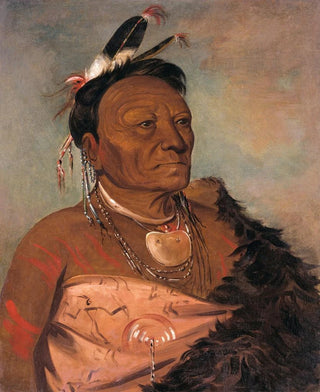Art print | WeeTRaShRo Chief of the tribe - George Catlin


View from behind

Frame (optional)
In the vast panorama of art history, some works stand out for their ability to capture the essence of a culture, evoke deep emotions, and tell forgotten stories. The WeeTRaShRo art print of the Chief of the Tribe - George Catlin is a perfect example. This painting, which immerses the viewer in the universe of Indigenous peoples of America, is much more than a simple representation; it is an open window onto a world rich in traditions and spirituality. Through this masterpiece, Catlin invites us to explore the nuances of tribal life, to feel the strength and dignity of the characters he depicts, and to reflect on the relationship between man and nature.
Style and uniqueness of the work
George Catlin's style is characterized by a blend of realism and romanticism. In WeeTRaShRo Chief of the Tribe, he succeeds in capturing not only the physical appearance of his subject but also the soul of the culture he represents. The vibrant colors, meticulously detailed elements, and dynamic composition of the work create an immersive atmosphere. Catlin does not merely depict a portrait; he tells a story, that of a chief embodying the values and traditions of his people. The decorative elements, traditional clothing, and facial expressions of the characters reveal an emotional depth that transcends time and space, allowing the viewer to feel the pride and resilience of the tribe.
The artist and his influence
George Catlin, painter and ethnographer of the 19th century, was a pioneer in the representation of Indigenous peoples of America. At a time when these cultures were often misunderstood or stereotyped, Catlin chose to immortalize them with respect and admiration. His work not only contributed to the preservation of these cultures but also raised awareness among the Western public of the richness and diversity of Indigenous ways of life. Through journeys across the American plains, he documented rituals, customs, and landscapes of these communities, creating a body of works that remains an essential reference. The influence of Catlin

Matte finish

View from behind

Frame (optional)
In the vast panorama of art history, some works stand out for their ability to capture the essence of a culture, evoke deep emotions, and tell forgotten stories. The WeeTRaShRo art print of the Chief of the Tribe - George Catlin is a perfect example. This painting, which immerses the viewer in the universe of Indigenous peoples of America, is much more than a simple representation; it is an open window onto a world rich in traditions and spirituality. Through this masterpiece, Catlin invites us to explore the nuances of tribal life, to feel the strength and dignity of the characters he depicts, and to reflect on the relationship between man and nature.
Style and uniqueness of the work
George Catlin's style is characterized by a blend of realism and romanticism. In WeeTRaShRo Chief of the Tribe, he succeeds in capturing not only the physical appearance of his subject but also the soul of the culture he represents. The vibrant colors, meticulously detailed elements, and dynamic composition of the work create an immersive atmosphere. Catlin does not merely depict a portrait; he tells a story, that of a chief embodying the values and traditions of his people. The decorative elements, traditional clothing, and facial expressions of the characters reveal an emotional depth that transcends time and space, allowing the viewer to feel the pride and resilience of the tribe.
The artist and his influence
George Catlin, painter and ethnographer of the 19th century, was a pioneer in the representation of Indigenous peoples of America. At a time when these cultures were often misunderstood or stereotyped, Catlin chose to immortalize them with respect and admiration. His work not only contributed to the preservation of these cultures but also raised awareness among the Western public of the richness and diversity of Indigenous ways of life. Through journeys across the American plains, he documented rituals, customs, and landscapes of these communities, creating a body of works that remains an essential reference. The influence of Catlin






